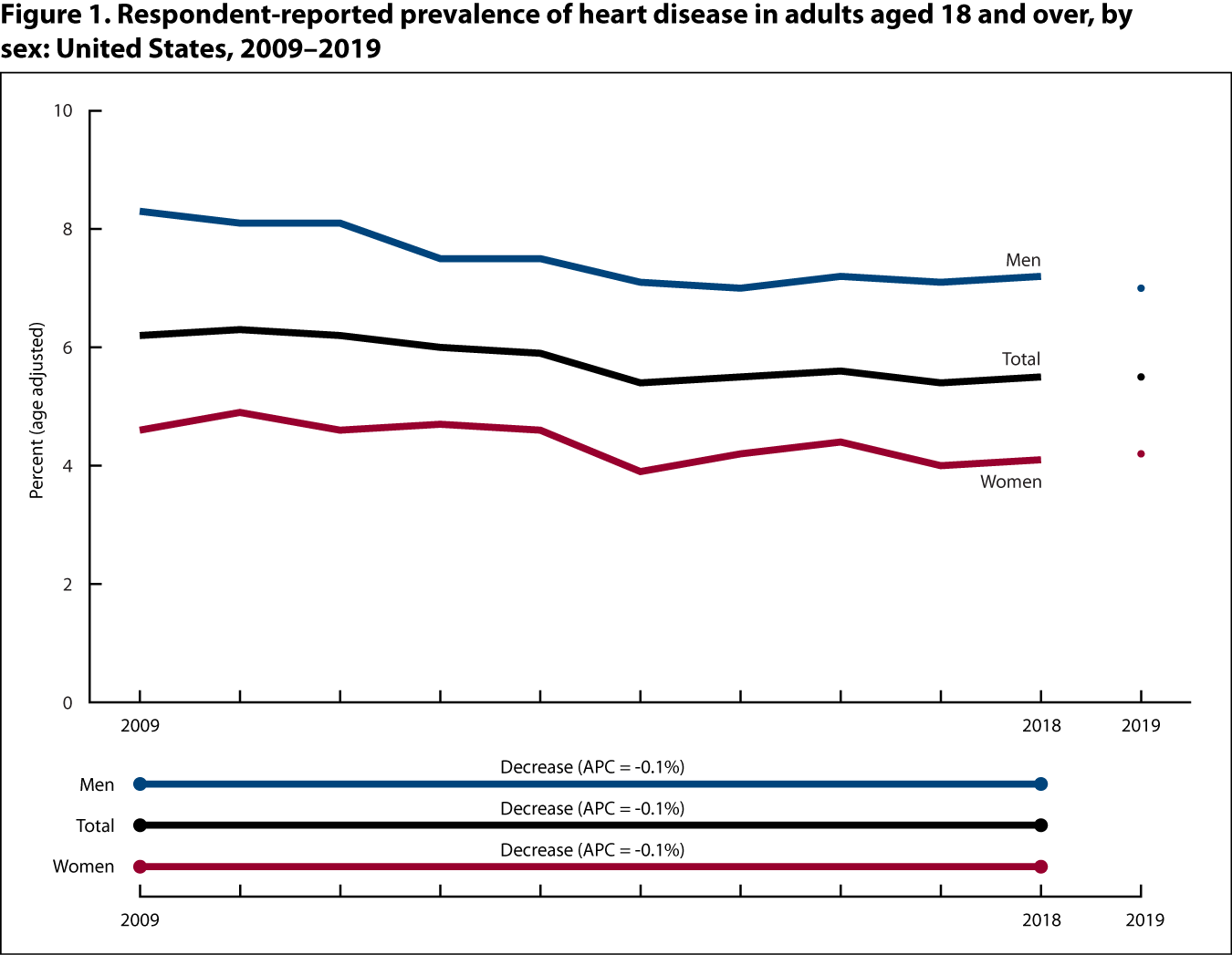Heart Disease Prevalence
The content on this page was last updated in June 2023. More recent estimates and visualizations may be available from the NCHS Data Query System.
Heart disease is the leading cause of death for men, women, people aged 45 and over, and most race and Hispanic-origin groups (Table LCODRace and Table LCODAge [1]). However, improvements in medical care and reductions in risk factors associated with heart disease, such as high blood pressure, high cholesterol, smoking, and obesity, have led to declines in heart disease morbidity and mortality (2–5).
Key Findings

The age-adjusted prevalence of heart disease in adults aged 18 and over decreased from 6.2% in 2009 to 5.5% in 2018. In 2019, 5.5% of adults reported that they had been diagnosed with heart disease. See Featured Charts for additional analysis and Notes for more information about analyzing trends using NHIS data.
SOURCE: National Center for Health Statistics, National Health Interview Survey. See Sources and Definitions, National Health Interview Survey (NHIS) and Health, United States, 2020–2021 Table HDPrv.
From 2009 to 2019, men were more likely than women to report having heart disease.

NOTE: APC is annual percent change.
SOURCE: National Center for Health Statistics, National Health Interview Survey. See Sources and Definitions, National Health Interview Survey (NHIS) and Health, United States, 2020–2021 Table HDPrv.
- From 2009 to 2019, the respondent-reported prevalence of heart disease was higher in men than in women.
- The age-adjusted prevalence of heart disease in men decreased from 8.3% in 2009 to 7.2% in 2018. In 2019, 7.0% of men reported having heart disease.
- The age-adjusted prevalence of heart disease in women decreased from 4.6% in 2009 to 4.1% in 2018. In 2019, 4.2% of women reported having heart disease.
Adults aged 75 and over had the highest prevalence of heart disease compared with younger age groups.

NOTES: “Stable” refers to no statistically significant trend during the period. APC is annual percent change.
SOURCE: National Center for Health Statistics, National Health Interview Survey. See Sources and Definitions, National Health Interview Survey (NHIS) and Health, United States, 2020–2021 Table HDPrv.
- From 2009 to 2018, the respondent-reported prevalence of heart disease decreased in adults aged 55–64 and 65–74 but remained stable in adults aged 18–44, 45–54, and 75 and over.
- In 2019, the prevalence of heart disease increased with age, reported by 1.0% of adults aged 18–44, 3.6% of adults aged 45–54, 9.0% of adults aged 55–64, 14.3% of adults aged 65–74, and 24.2% of adults aged 75 and over.
Download the data
Respondent-reported prevalence of heart disease in adults aged 18 and over, by selected characteristics: United States, selected years 1997–2019
SOURCE: National Center for Health Statistics, National Health Interview Survey.
Leading causes of death and numbers of deaths, by sex, race, and Hispanic origin: United States, 1980 and 2019
SOURCE: National Center for Health Statistics, National Vital Statistics System, Mortality.
Leading causes of death and numbers of deaths, by age: United States, 1980 and 2019
SOURCE: National Center for Health Statistics, National Vital Statistics System, Mortality.
- Heart disease prevalence: Based on questions about whether respondents had ever been told by a doctor or other health professional that they had coronary heart disease, angina (angina pectoris), or a heart attack (myocardial infarction). See Sources and Definitions, Heart disease.
- Heron M. Deaths: Leading causes for 2019. National Vital Statistics Reports; vol 70 no 9. Hyattsville, MD: National Center for Health Statistics. 2021.
- Centers for Disease Control and Prevention. About heart disease. Available from: https://www.cdc.gov/heartdisease/about.htm.
- Ford ES, Ajani UA, Croft JB, Critchley JA, Labarthe DR, Kottke TE, et al. Explaining the decrease in U.S. deaths from coronary disease, 1980–2000. N Engl J Med 356(23):2388–98. 2007.
- Heron M, Anderson RN. Changes in the leading cause of death: Recent patterns in heart disease and cancer mortality. NCHS Data Brief, no 254. Hyattsville, MD: National Center for Health Statistics. 2016.
- Sanchis-Gomar F, Perez-Quilis C, Leischik R, Lucia A. Epidemiology of coronary heart disease and acute coronary syndrome. Ann Transl Med 4(13):256. 2016.

